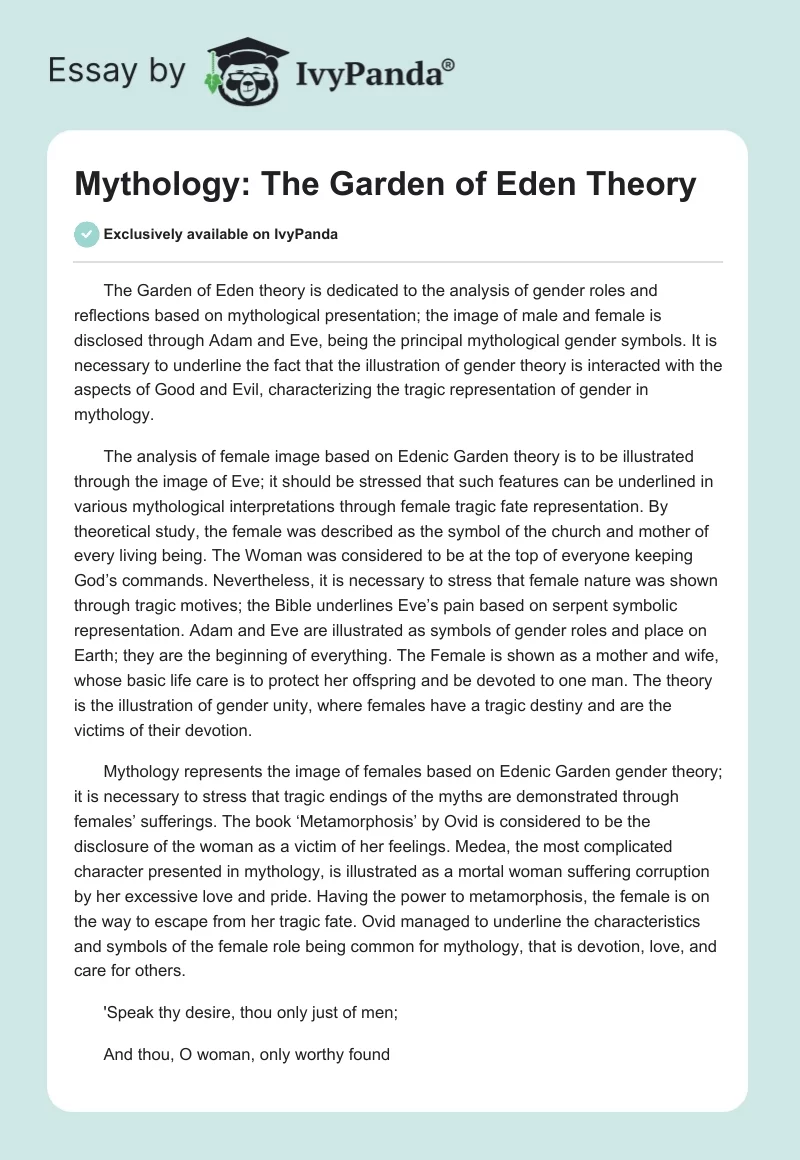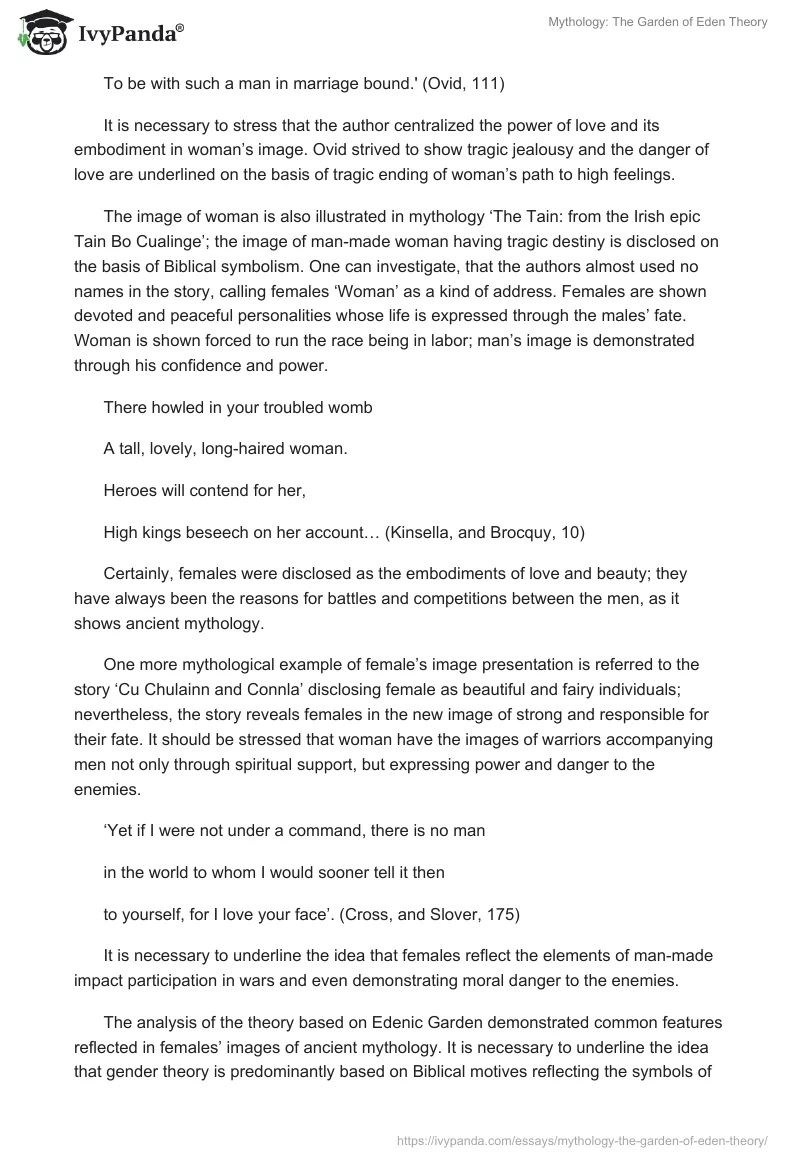The Garden of Eden theory is dedicated to the analysis of gender roles and reflections based on mythological presentation; the image of male and female is disclosed through Adam and Eve, being the principal mythological gender symbols. It is necessary to underline the fact that the illustration of gender theory is interacted with the aspects of Good and Evil, characterizing the tragic representation of gender in mythology.
The analysis of female image based on Edenic Garden theory is to be illustrated through the image of Eve; it should be stressed that such features can be underlined in various mythological interpretations through female tragic fate representation. By theoretical study, the female was described as the symbol of the church and mother of every living being. The Woman was considered to be at the top of everyone keeping God’s commands. Nevertheless, it is necessary to stress that female nature was shown through tragic motives; the Bible underlines Eve’s pain based on serpent symbolic representation. Adam and Eve are illustrated as symbols of gender roles and place on Earth; they are the beginning of everything. The Female is shown as a mother and wife, whose basic life care is to protect her offspring and be devoted to one man. The theory is the illustration of gender unity, where females have a tragic destiny and are the victims of their devotion.
Mythology represents the image of females based on Edenic Garden gender theory; it is necessary to stress that tragic endings of the myths are demonstrated through females’ sufferings. The book ‘Metamorphosis’ by Ovid is considered to be the disclosure of the woman as a victim of her feelings. Medea, the most complicated character presented in mythology, is illustrated as a mortal woman suffering corruption by her excessive love and pride. Having the power to metamorphosis, the female is on the way to escape from her tragic fate. Ovid managed to underline the characteristics and symbols of the female role being common for mythology, that is devotion, love, and care for others.
‘Speak thy desire, thou only just of men;
And thou, O woman, only worthy found
To be with such a man in marriage bound.’ (Ovid, 111)
It is necessary to stress that the author centralized the power of love and its embodiment in woman’s image. Ovid strived to show tragic jealousy and the danger of love are underlined on the basis of tragic ending of woman’s path to high feelings.
The image of woman is also illustrated in mythology ‘The Tain: from the Irish epic Tain Bo Cualinge’; the image of man-made woman having tragic destiny is disclosed on the basis of Biblical symbolism. One can investigate, that the authors almost used no names in the story, calling females ‘Woman’ as a kind of address. Females are shown devoted and peaceful personalities whose life is expressed through the males’ fate. Woman is shown forced to run the race being in labor; man’s image is demonstrated through his confidence and power.
There howled in your troubled womb
A tall, lovely, long-haired woman.
Heroes will contend for her,
High kings beseech on her account… (Kinsella, and Brocquy, 10)
Certainly, females were disclosed as the embodiments of love and beauty; they have always been the reasons for battles and competitions between the men, as it shows ancient mythology.
One more mythological example of female’s image presentation is referred to the story ‘Cu Chulainn and Connla’ disclosing female as beautiful and fairy individuals; nevertheless, the story reveals females in the new image of strong and responsible for their fate. It should be stressed that woman have the images of warriors accompanying men not only through spiritual support, but expressing power and danger to the enemies.
‘Yet if I were not under a command, there is no man
in the world to whom I would sooner tell it then
to yourself, for I love your face’. (Cross, and Slover, 175)
It is necessary to underline the idea that females reflect the elements of man-made impact participation in wars and even demonstrating moral danger to the enemies.
The analysis of the theory based on Edenic Garden demonstrated common features reflected in females’ images of ancient mythology. It is necessary to underline the idea that gender theory is predominantly based on Biblical motives reflecting the symbols of Adam and Eve in various myths; besides, one should note that love and devotion appeared to be central features characterizing mythological ancient women. Tragic endings of mythological stories are characterized by mortal images females had in ancient period; fatal role of woman in the life of men made them suffer the danger of love and care. The necessity to protect their offspring, remain the embodiment of charm and beauty, and be devoted to the only man, are the principle characteristics of women taken from the Adam and Eve symbolization. Biblical influence of Edenic Garden gender theory is vividly underlined in many outstanding mythological stories highlighting the theme of man and woman relationships.
References
Cross, T. and Slover, C. Ancient Irish tales. Barnes & Noble, 1969.
Kinsella, Th. And Brocquy, L. The Táin: from the Irish epic Táin Bó Cualinge. Louis Le Brocquy. 2002.
Ovid, A. and Kenney, J. Metamorphoses. Oxford University Press, 1998.


